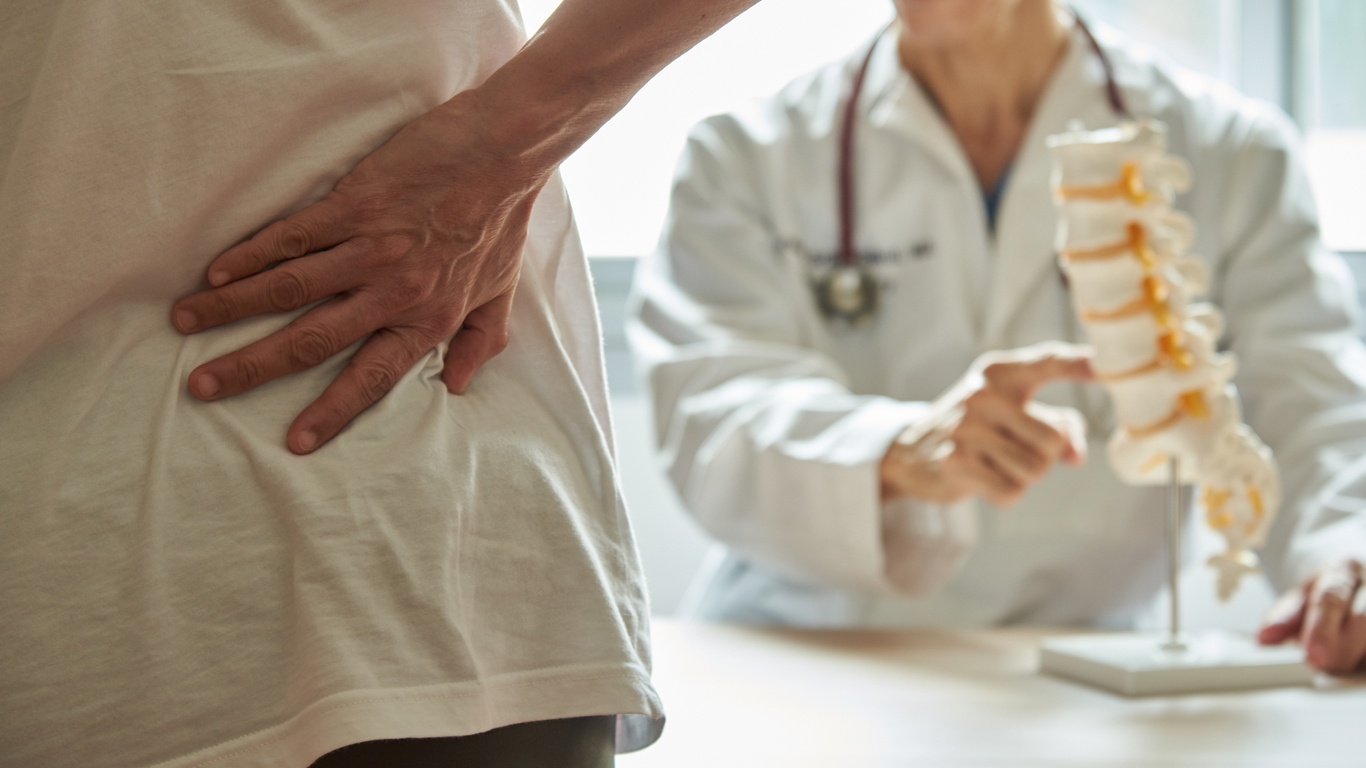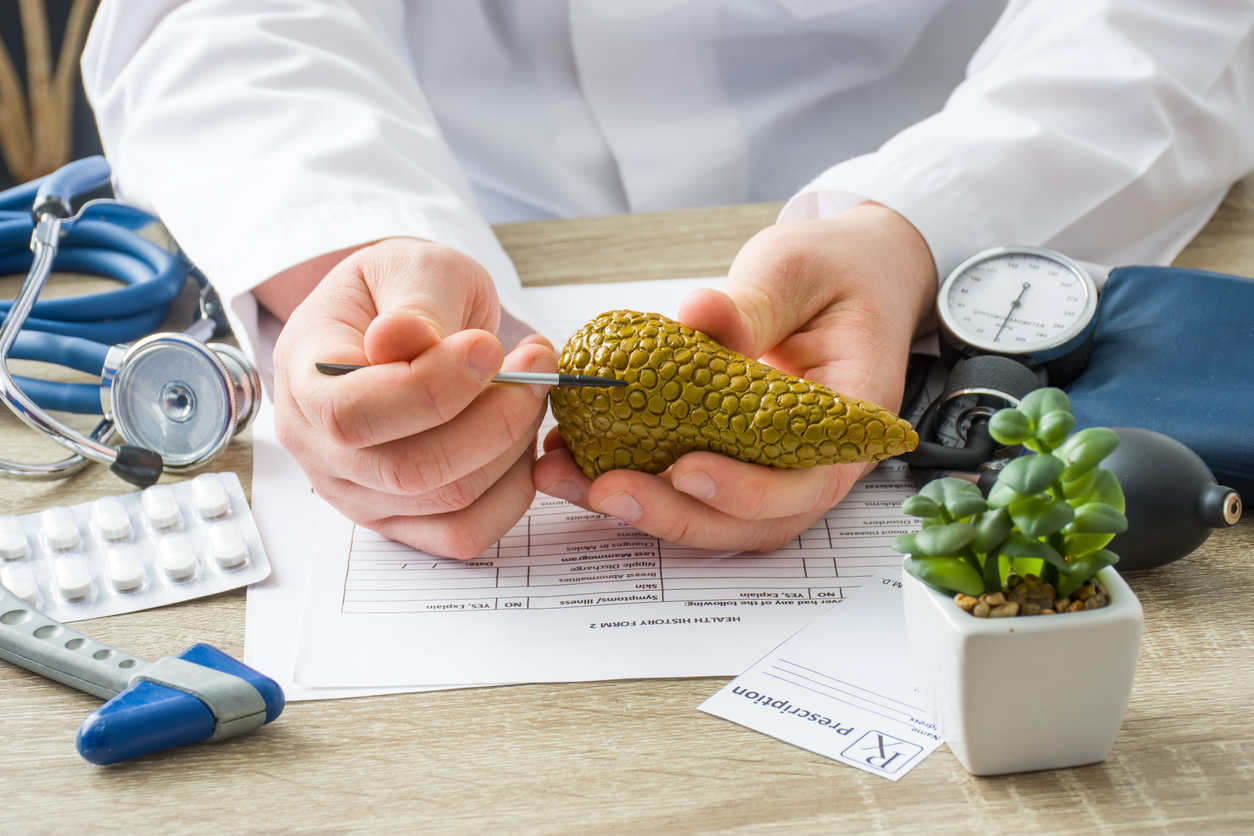Back Pain Can Be a Symptom of Pancreatic Cancer
The symptoms of pancreatic cancer may be subtle, varied, or—in the early stages of the disease—non-existent. That’s why “pancreatic cancer is the most lethal cancer in the human body, with overall five-year survival rates at just about seven percent despite all the advances over the past decades,” according to the Mayo Clinic News Network. “There are no telltale signs for pancreatic cancer, and symptoms like weight loss, abdominal pain, jaundice, and appetite loss are nonspecific.”
That’s why knowing which symptoms to watch for, no matter how unrelated they may seem, is crucial—as is being aware of any factors that may put you at a higher risk for getting developing pancreatic cancer. Read on to find out why back pain might be a warning sign of this deadly disease, and when to get it checked out.
READ THIS NEXT: If You Notice This on Your Face, Get Checked for Cancer.
“The pancreas is located to the back of the abdomen behind the stomach laying on the spine, in what is called the retroperitoneal location,” says James Farrell, Professor of Medicine and Director at the Yale Center for Pancreatic Disease at Yale Cancer Center and Smilow Cancer Hospital. The pancreas has an exocrine gland and an endocrine gland, which perform digestive and hormonal functions. The exocrine function produces enzymes that help with digestion, according to the Cleveland Clinic. The endocrine function is to send out hormones that control the amount of sugar in your bloodstream.
“Pancreatic cancer typically starts in the ducts of the pancreas,” Chee-Chee Stucky, MD, tells the Mayo Clinic. “Small changes in the cellular DNA result in uncontrolled multiplication and accumulation of cells in clusters called tumors. If untreated, these cancer cells can spread outside of the pancreas to other parts of the body.”

Some of the risk factors for pancreatic cancer can’t be controlled. The American Cancer Society advises that family history and genetics may indicate a higher risk for the disease, as well as age, gender, and race.
“The risk of developing pancreatic cancer goes up as people age,” the site says, noting that almost all pancreatic cancer patients are over 45, and approximately two-thirds are at least 65.
“Men are slightly more likely to develop pancreatic cancer than women,” the American Cancer Society reports. “African Americans are slightly more likely to develop pancreatic cancer than whites.”
Research has shown that there may be a link between blood type and the risk of certain diseases, including pancreatic cancer. And the American Cancer Society cautions that some lifestyle choices—such as diet, physical inactivity, tobacco smoking, and heavy alcohol use–can impact your risk of the disease.
For more health news sent directly to your inbox, sign up for our daily newsletter.

Pancreatic cancer can go undetected for a long period of time because of where the organ is located. “The pancreas is deep inside the body, so early tumors can’t be seen or felt by health care providers during routine physical exams,” the American Cancer Society explains. “People usually have no symptoms until the cancer has become very large or has already spread to other organs.”
When warning signs do arise, the symptoms depend on where the cancer is in the pancreas. “You can have a relatively small tumor in the very end of the pancreas, near the opening to the duodenum, that can cause jaundice,” Matthew Walsh, MD, told a Cleveland Clinic podcast.
As a tumor grows from the pancreas and invades certain nerves and organs, this can cause mid-back pain. “Some people also report that they feel pain in their shoulder or under their shoulder blade,” warns Pancreatic Cancer Action. “Other people feel pain in their back and abdomen at the same time.”

While back pain can be a warning sign of pancreatic cancer, it’s also a very common condition in adults. “540 million people around the world are affected by back pain at any one time,” reports The Good Body. “Eight in ten Americans will experience back pain in their lifetime.”
Osteoporosis and muscle strain are just two of the potential reasons for back pain, but the cause can be much more serious. Pain in varying areas of the back can signal different types of cancers that include lung cancer, blood and tissue cancer, and pancreatic cancer, says Healthline, which also warns to look for other symptoms like changes in the bathroom, sudden weight loss, and weakness, tingling, or numbness in your arms and legs.
Farrell also cautions that other symptoms associated with pancreatic cancer include “weight loss, dark urine, anorexia, nausea, vomiting, depression, pancreatitis, [and] new onset diabetes.”
" Conservative News Daily does not always share or support the views and opinions expressed here; they are just those of the writer."




Now loading...